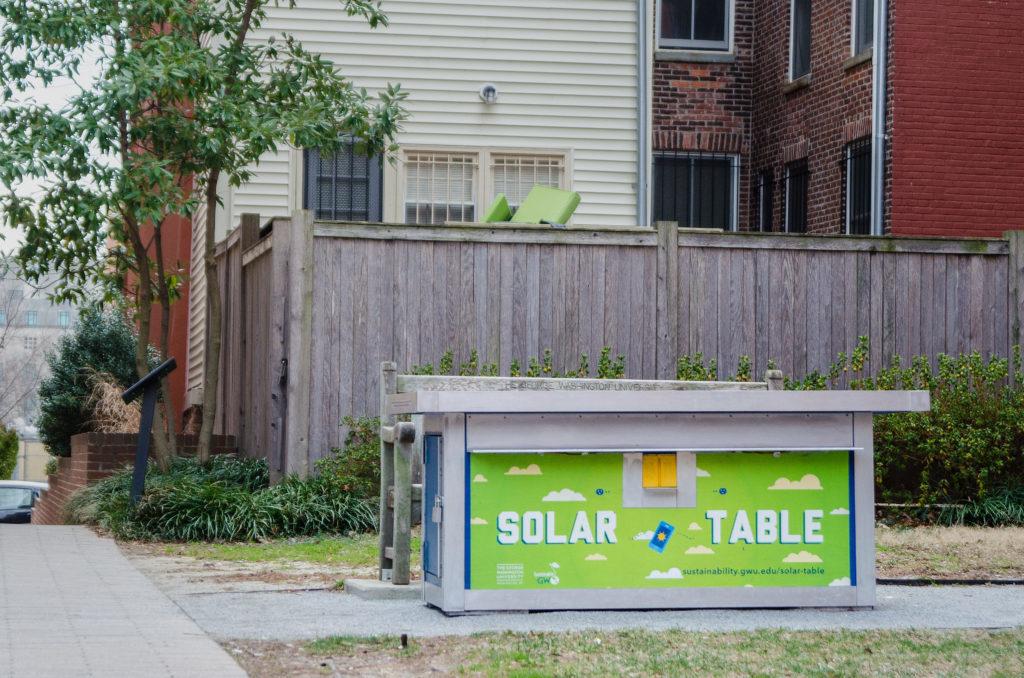Students have the chance to show off their solar skills by designing charging stations that run on solar power.
GW’s sustainability office is holding a design competition for students to build solar charging stations for outdoor campus spaces. The contest is being held to celebrate the University’s first anniversary of using 50 percent solar power, officials said.
Competing students will form teams to design and build a charging station in Kogan Plaza. Models will be judged based on qualities like appeal, reliability, functionality and maintenance. The winning team will be awarded $10,000 to construct their design between this summer and the fall semester.
The intention of the contest is to help students utilize outdoor campus space to charge their electronics with solar energy, according to the sustainability office’s website. But some students say that it can be challenging to achieve that goal on campus.
Ben Pryde, a 2016 alumnus, designed a solar charging table his freshman year with $5,000 in funding from the Center for Student Engagement, the Student Association and the Residence Hall Association. Pryde said GW’s urban campus posed obstacles – like a lack of open space and sometimes-cloudy weather – for his project.
“Having a project like that on an urban campus is tough,” Pryde said. “I suspect some of that will be mitigated by the new engineering building they have and the resources that will provide.”
Since the installment of this first solar table in Square 80 in 2013, GW has made solar power a focus of the University’s other sustainability projects. Last year, GW partnered with Duke Energy Renewables, the GW Hospital and American University to obtain 50 percent of its electricity energy from three solar power farms in North Carolina. Several buildings on GW’s campus, including District House, are powered by this solar energy and have gotten national recognition for their green features.
Meghan Chapple, the director of the Office of Sustainability, said in an email that the agreement with Duke Energy Renewables ensures that GW will receive solar power for a 20-year period. The project saves the University money because the agreement provides solar energy at a fixed price that is lower than the cost of other power, she said.
As traditional power prices are expected to increase over the next 20 years, GW’s partnership will provide more cost-saving opportunities, she said. She added that officials will continue to look at other opportunities to use renewable sources for the remaining 50 percent of the University’s energy.
“This project was sized for half of the total electricity needs at GW,” Chapple said. “We will continue to consider other renewable options in the future.”
Chapple said that the $10,000 prize for the solar design competition will be funded by “standard budgetary resources.”
Tammie McGee, a spokesperson from Duke Energy Renewables, said the University’s model of obtaining solar power from an outside source could set an example for other institutions in big cities.
“Some universities may have some solar on their parking deck or on rooftops, but you guys are landlocked by a city so you have limited space where you could put a large scale solar,” McGee said.
McGee added that GW’s commitment to solar energy is part of a nationwide trend of institutions transitioning to renewable energy.
“Of course, solar can’t do 100 percent of the work 100 percent of the time because you can’t generate solar energy at night or on rainy or cloudy days, but it can certainly be a component of a university’s energy portfolio,” she said. “And as everyone gets more carbon conscious, that’s becoming more important.”
Duke Energy Renewables has also funded research grants for three GW faculty-led projects on different aspects of solar energy.
Ekundayo Shittu, an assistant professor of engineering management and systems engineering, was a grant recipient last year. Shittu’s research focused on how to minimize cost and emissions to maximize the efficiency of microgrids, which are networks of electricity sources.
He said offering students a specific maximum budget will incentivize them to design products that offer the biggest bang for their buck.
“We’re not trying to make inventors, we’re trying to make innovators,” Shittu said. “I think the $10,000 being offered is a great paradigm shift that I think shows a lot about GW’s commitment to sustainability.”





